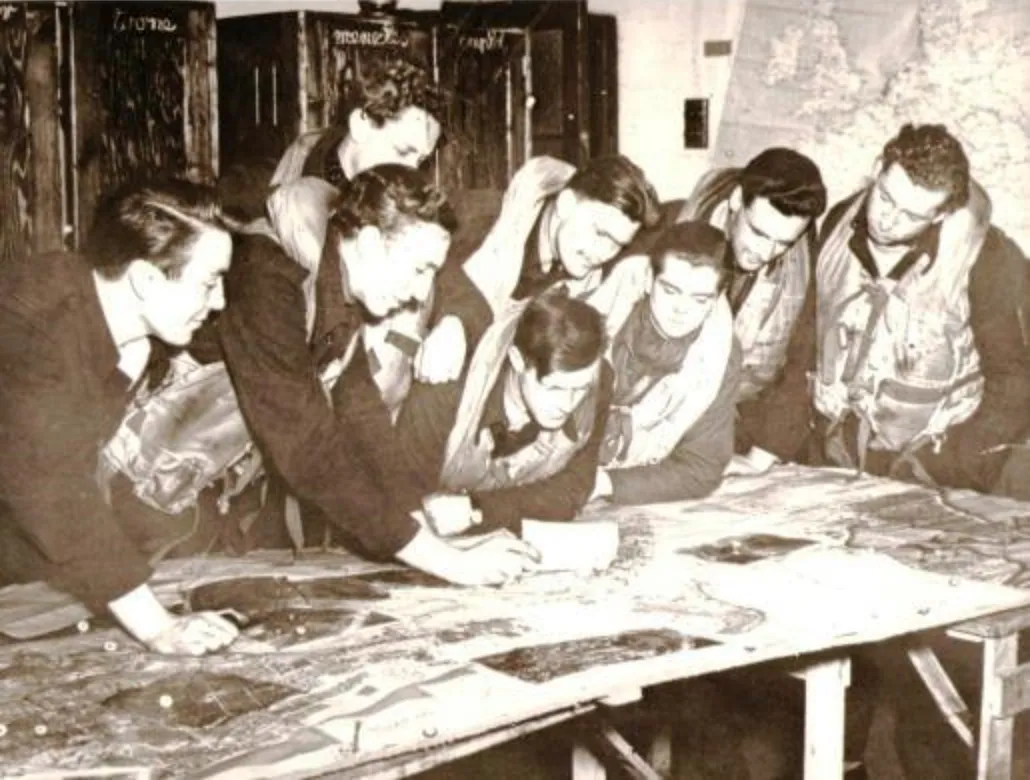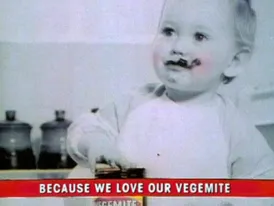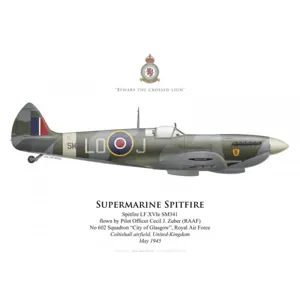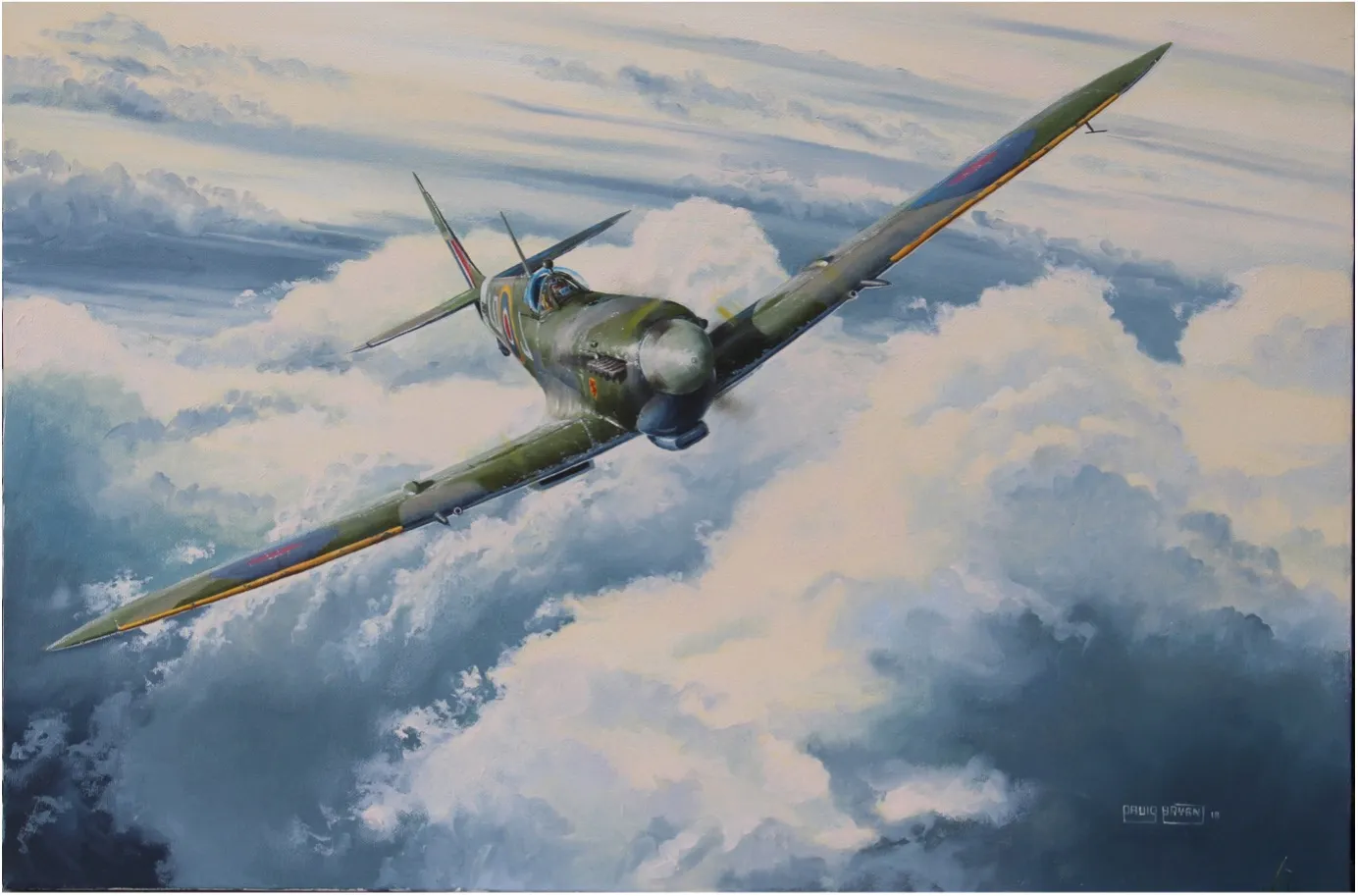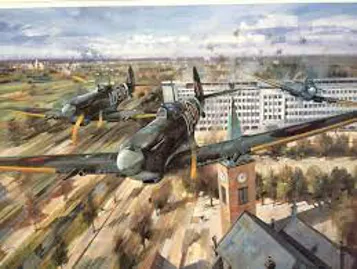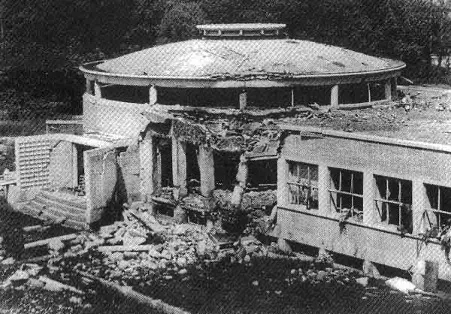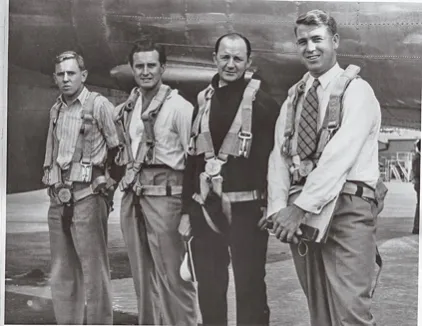FLGOFF Cecil Joseph Zuber 424617
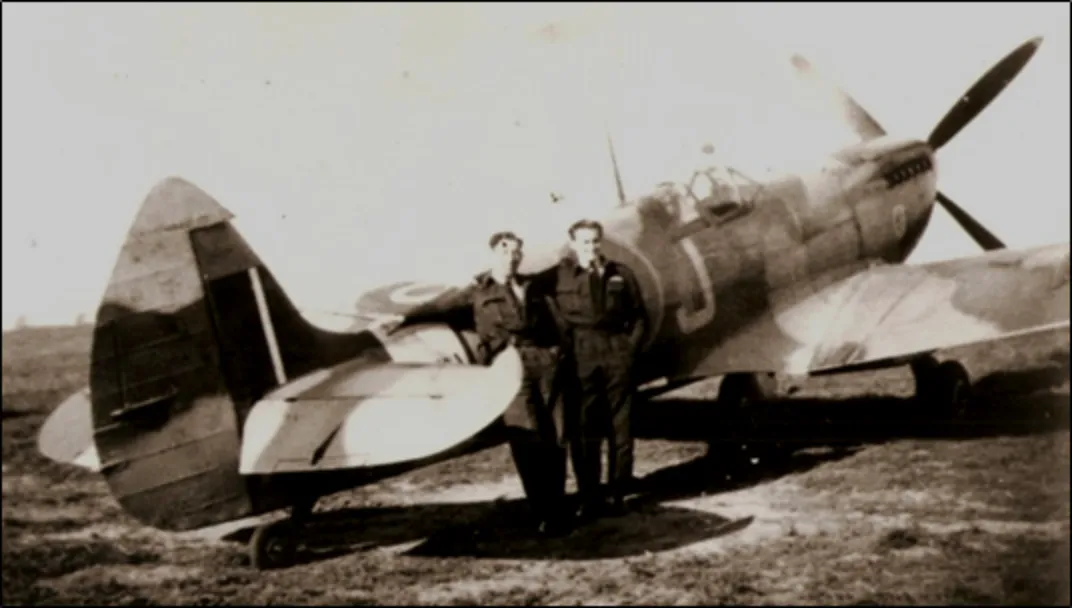


| Squadron/s | 602 SQN RAF |
| Rank On Discharge/Death | Flying Officer (FLGOFF) |
| Nickname | Cec |
| Mustering / Specialisation | Pilot |
| Date of Birth | 09 Jan 1923 |
| Date of Enlistment | 30 Sep 1942 |
| Date of Death | 30 Mar 1994 |
| Contributing Author/s | Geoff Zuber Richard Zuber The Spitfire Association |
Born on the 9 January 1923, Cecil was the only son of Victor Cecil and Florence Zuber.
Cec, as he would be known through his life, was brought up in St Peters in the inner southern suburbs of Sydney. A working-class family, his devoted parents made sure he never went without. Determined her boy would do well in life, Flo soon entered Cec in a competition, just a year after he was born, and Cec won. He became the "Vegemite Kid" for the year 1924 and a photograph of a chubby and healthy Cec was used in advertising campaigns promoting Australia's iconic sandwich spread.
Just 7 years old when the great depression hit, Cec was lucky enough to have a father who was working full time. At times 9 people, uncles, cousins, and friends lived in their small 2-bedroom semi-detached house and while times were tough, they had a roof over their heads and food to eat. These tough times made Cec determined to make something of his life and set him up with a will to succeed. Only having one pair of shoes, to be worn in winter, or his weekly treat of a frozen orange from the street vendor, it made him determined to have a less difficult future.
As a teenager Cec and his mates would go for long walks and mostly head for what is today Sydney Kingsford Smith airport. Back then it was just a grass field with some hangers and huts. From these days of larking about, a lifetime passion and a career in aviation would grow.
When the Second World War Started Cec was completing his schooling. By his own admission he was not a brilliant student but always good at maths. This would lead him to his first job, a trainee accountant in the Public Service. As a public servant, Cec could have sat the war out as a protected worker, but at the earliest opportunity he resigned his position and joined up.
Joining up for Cec was a lottery, not without risk, for his ultimate goal of becoming a pilot. Every enlisted man entered the army first and so on 14 September 1942, Cec became Private C J Zuber, 247399, Australian Army. From there recruits were assessed during basic training for their skills and where best to enlist their abilities for the war effort. Luckily for Cec, after just weeks in the army spent drilling and peeling potatoes, the boring bit and driving tanks, the fun bit, he got the call up from the Air Force. He was demobbed from the Army and mobilised into the Royal Australian Air Force on 29 September 1942.
Now Sergeant C J Zuber, 424617, Royal Australian Air Force, Cec was put through weeks of testing to assess his abilities. One of the tests used to assess the recruits and help decide what they would end up doing, was for the recruits to look at two differently coloured and separate images and see if they could bring them together to put a "pigeon in a cage". Passing this test put you on the path to fighter training as it proved you weren't colour blind and would be able to sight enemy aircraft easily and quickly. Cec commented to the Medical Officer in charge that he'd no trouble with this test to which the Officer replied, "well Caldwell couldn't do it!". This was a reference to Clive "Killer" Caldwell who would become the highest scoring RAAF fighter Pilot with 28.5 kills. It was this that Caldwell attributed to his difficulty with deflection shooting and lead him to develop what became known as "shadow shooting". He learnt this skill during his time in Africa and became it became widely adopted.
Selected for pilot training, Cec was soon on his way to Canada to begin basic flight training. He started basic training, at No.6 RCAF Training School, Dunnville, Ontario. Flying Tiger Moths and Westland Wapiti's among other aircraft, he got to grips with the practical and theoretical realities of piloting, and he loved it. After 3 months of basic training at the Service Flying Training School, Cec was awarded his wings. A further period of training at an Advanced Flying Unit saw Cec selected for fighter training and moved on to Number 1 OTU Bagotville, Ontario. Many months more training honed skills as a fighter pilot. The North American Harvard advanced trainer came next with many of the characteristic of fighters like the Spitfire, particularly its stall/spin characteristics. Young pilots like Cec learned to harness these dangerous characteristics and turn them to advantage with fighters they were about to fly and ultimately fight in.
After nearly 18 months of flight training, time in Link trainers, endless classes and study, the time finally arrived to fly in a Hurricane. Cec was handed 3 sheets of paper, printed both sides with the heading "Standard Hurricane cockpit checks" and told to memorise it! Your first flight was your first solo; a bit overwhelming. Once he was deemed competent, Cec like many before him sat in the cockpit of a Hurricane and went through the pre and start up checks. As the Hurricane burst into life, Cec had a moment of realisation that he was on his own at the controls of one of the high-performance fighters of its era. The Hurricane and Spitfire engine would quickly overheat when on the ground. For Cec the moment had come; sit on the airfield and wait for the engine to overheat or take off. As the throttles opened his war as a fighter pilot began.
As part of their development, trained OTU pilots were formed into squadrons and carried out "operational" sorties. Flying out of Bagotville, Quebec, Cec had his first taste of operational flying doing coastal patrols over the Canadian Atlantic coast looking for enemy surface craft and submarines. While rarely mentioned in any literature, these patrols were armed and had they spotted any enemy, they were permitted to engage.
It wasn't long before posting to England arrived. For Cec this was the most dangerous part of his war effort so far. He boarded the RMS Aquitania, what he described as "a dreadful rusty old tub that should have been scuttled years before" to cross the perilous Atlantic Ocean teeming with German submarines.
Arriving in Southhampton three weeks later it was off to Brighton and billeting at The Grand Hotel. For an Aussie the weather was unrelentingly cold, wet, and typically English, a portent forte flying to come. A resounding memory was that the food was boring and un-appetising, certainly no Vegemite for this kid!
In 1984 the Grand Hotel was to be the scene of an assassination attempt on Prime Minister Margaret Thatcher by the IRA, detonating bombs at the Conservative Party annual conference.
Orders arrived shortly and Cec was seconded to the Second Tactical Air Force (2nd TAF) at 602 City of Glasgow Squadron. The 2nd TAF included Squadrons from the Commonwealth, including RAAF 453 Squadron.
First stop was 56 OTU for conversion to the Packard Merlin powered Spitfire Mk XVI's. Up to this point Cec had flown Mk 2, Mk V and Mk IX Spitfires and at 602, the Mk XVI's. At the time he was attached, 602 Squadron was flying out of RAF Coltishall in Norfolk on the mid east coast of England. 602 Squadron had a distinguished record as a fighter squadron having fired the opening shots in the aerial war against the Luftwaffe shooting down an He-111 over the Firth of Forth, a scene famously depicted in the Battle of Britain movie of 1969.
602 Squadron, one of the Auxiliary Squadrons in existence well before the war, was the first of these to be kitted out with the Spitfire just before the outbreak of war and flew almost every type throughout the war in various roles. During the Battle of Britain many of the Squadron's pilots became aces of the period. Commanding Officer during the Battle was Squadron Leader and later Air Vice Marshal "Sandy" Johnstone, CB, DFC, AE, MiD who flew with his LO-J markings. The Squadron "crack shot" would then be accorded this marking once "The Boss" left the Squadron in 1941. This is the Spitfire marking that Cec would fly when he was established in the Squadron.
The battle against Hitler's Vergeltungswaffen or Retaliatory Weapon, the notorious V1 and V2 was in full swing. 602 Squadron work concentrated on anything to do with these threats. The campaigns code named Operation Diver (anti-V1) and Operation Big Ben (anti-V2), were to prove dangerous and pivotal in reducing the threat, at the source. Operation Big Ben was so secret it remained largely classified until 2004. These sorties by 602, 603, 124 and RAAF 457 Squadrons, acting on intelligence fed back to Fighter Command through Operation Crossbow was planned by a new group known as the Special Operations Executive (SOE). SOE were tasked with gathering intelligence from Western Europe through covert operations behind enemy lines. This important and highly dangerous work was vital to the war effort by identifying targets of interest for Fighter and Bomber Commands. The man behind the SEO, and fully engaged in their daily efforts, often behind enemy lines, was Ian Fleming author of the James Bond books. The books thought to be fictional by many, are in fact very much grounded in Flemings' war time experiences.
Patrols over the Canadian Atlantic coast did not prepare Cec for the real war. His first mission was a bombing raid on enemy shipping in Den Helder Harbour in The Netherlands. With a 250-pound bomb strapped to each wing and a 500-pound bomb slung under the fuselage, Cec and five other Spitfires set course for their target. Crossing the North Sea at 5000 feet, the Spitfires entered a steep dive just before they reached the harbour. With guns and canons firing at them from the ships and flak shells bursting all around from the land defences, they released their bombs at just under a thousand feet. Cec openly admitted to being completely terrified and had no idea where his bombs landed, sure he had hit nothing. It was a sobering experience for the 22-year-old, and he told me that his only thoughts as they were diving at their target was "bloody hell". This raid brought the reality of his new life into sharp focus concentrating his mind on his flying from then on.
From this baptism of fire Cec would settle into his new life, make lifelong friends, and take on a leading role as one of the squadrons marksmen.
Richard Zuber recounts a conversation with former pilot and 602 Squadron veteran Tommy "Cupid" Love, a self described feisty wee Scotsman and the smallest pilot in the RAF at the time. Cupid explained to me; "Your Dad had two nicknames, ‘Zuberman' and ‘Shufti'. Zuberman is self-explanatory (RZ - we still have his parachute release flap decorated with a picture of "Superman" in flight and the nickname emblazoned on it by the Squadron artist, fellow pilot Michael Francis). Cupid went on to explain that he became known as "Shufti" because he was Australian. You Australian's have a love of naming things the opposite of their actual appearance, so if you have red hair your nickname would be" Blue". In Scotland Shufti means ‘always first in', so for Cec, being an Aussie, they turned this around to mean "always last in". Because of his accurate bombing and strafing, Cec was often kept till last on raids to pick up any missed targets. Your Dad and me were friends all our lives and one reason is that the day I ditched in the Channel he circled and kept the Huns from capturing me. (Cupid gave Richard Zuber his ditching felt in recognition, and we have it to this day – GZ)
Another of the pilots who would remain Cec' friend through their lives was Stan Sollitt. Stan is recorded as being the first pilot to successfully do a loop in a helicopter and was part of the predecessors to the Red Arrows, known as the Black Arrows.
I had the privilege of flying with Dad in my Beechcraft and after a few circuits, with Dad following through, he took over from the right hand seat. The first of his landing approaches was quite a bit too high with my response being “I have control” and immediately going around (despite Dad having 24,000 more hours than me and more than 250 on Beechcraft types). The next 6 landings he did kissed the runway. I will never approach either his capability or humility and admire him as a pilot and wonderful father. He remains my inspiration for the task ahead at the Spitfire Association.
On March 18, 1945, came the most audacious Operation Big Ben raid, also now recognised as one of the most daring of the war.
Six Spitfires of 602 Squadron loaded with two 250-pound and one 500-pound bombs, led by CO Squadron Leader "Max" Sutherland took off for the Royal Dutch Shell Oil Company (Baataschfe Mex) building in The Hague.
Two 2nd TAF Squadrons, 124 squadron and the Australians of 453 squadron would create a diversion by bombing the nearby racecourse at Duindigt, also a well-known area of interest, while the Spitfires of 602 made their attack. The building was identified through Crossbow intelligence as one used to house leading scientists and laboratories involved in the development of the V2 rockets.
Departing Coltishall and climbing to 2000 feet, the Spitfires crossed the North Sea until they reached the Dutch coast. From this point they entered a steep dive and levelled out at roof top height, below the level of the trees and travelling at over 400 miles an hour. With the target in sight the Spitfires flying line abreast, dropped even lower and had to pull up slightly to get over the brick wall that surrounded the building. They opened- up with their machine guns and canons, shattering the windows and then just metres from the building let go of their bombs. The bombs were set with an 11 second delay on the fuse to allow the pilots a chance to get clear before they exploded. Cec's plane took several hits and skidded starboard as he released his bombs. The next thing he knew was the sight of the Shell oil building filling the entire windscreen of his cockpit. Pulling back on the control column, Cec reckons he couldn't have made it over the building by more than a few inches.
But it wasn't over. As he flew over the top of the building, he was faced with the spire on top of the church that sat just behind. In the blink of an eye, he tipped his right wing up and narrowly missed the golden cockerel of the weathervane, all of this going on at over 400 miles an hour with intense flak burst and machine gun fire all around them.
Having lost most of his starboard tailplane, Cec made his way to Flanders and landed at an airfield at Ursel that had been captured and occupied by British forces in September 1944. This was the first time Cec had landed on a PSP (perforated steel planking) landing strip. He said the unbelievable noise and vibrations landing on it scared the life out him that he thought he'd lost one of his tyres in the raid as well. Well, he hadn't but both he and the Boss had to get their Spitfires repaired. Sutherland took Cec's back to base as it was repaired first and Cec returned in The Boss's kite later that day. When he returned to base, he described the attack to his good mate Stan Sollitt in typical understated Aussie fashion as "being a bit hectic".
602 Squadron's war came to an end on 15 May 1945. Cec was demobbed and awaiting new orders.
The war in Europe was over but the war with the Japanese was far from finished. Shortly after he Cec left the 602 lads, the news that sent shivers down his spine arrived, he was to be sent for training to operate off aircraft carriers where Spitfire Association stalwart CMDR Nat Gould (dec'd) would be one of his instructors in the fine but dangerous art of landing and departing Seafires from carriers. This was not something he had ever wanted but you weren't given a choice. Much to his relief, the war with Japan ended before Cec had to do any carrier-based work.
As part of the relief personnel on operations in Japan, Cec had the chance to see the devastation of Hiroshima first-hand. He was demobbed in 1946 and while his RAAF career was at an end, he remained in the Airforce Reserves for many years.
After the war Cec applied for a job with QANTAS and was accepted for flying duties. He said he was probably the luckiest pilot to ever fly with QANTAS. Given that he was a single engine spitfire pilot in a world full of ex-heavy multi-engine bomber and transport pilots, Cec put his successful job application down to the last question the interviewer asked him, – "so young man, where do you go to church?". Cec answered, St Andrews in Sydney. The interviewer replied, "ah yes, good church, surprised I haven't seen you there!" and that was the start of a life in commercial aviation.
His years at QANTAS would prove to be a wonderful time and gave him an opportunity to fly some of the truly iconic planes to have graced the sky. His career started in the classic flying boats of QANTAS Empire Airways, carrying passengers and the Royal Mail on the Shorts Sandringham (civil Sunderlands) and Catalinas from QANTAS international airport at Rose Bay, Sydney. QANTAS were the pioneers of what we today call the Kangaroo route, the journey to Europe and the UK. We take it for granted now, but back in the day of the flying boats this was a 10-day trip with stops across Australia, the Asian continent and Europe on the way. This was a truly glamorous time in air travel, but pilots and crew really had to know their stuff. Flying at night required navigation by the stars and was quite literally done with a sextant through a perspex bubble in the cockpit.
From the flying boats Cec moved on to Constellations and Super Constellations. These were wonderful aircraft but became nicknamed "The best 3 engine aircraft in the sky" as it was likely you would lose power on at least one of their engines on every trip. This was troublesome for airlines around the world and caused lots of down time for aircraft as they waited for repairs or replacement engines. QANTAS came up with a unique solution. Chief engineer Ron Yates developed an oversized cowling in the bomb bay of an Avro Lancastrian (civilian version of the Lancaster bomber). The idea being they could transport engines around the world to replace ones on unserviceable aircraft. The designs were approved by QANTAS management and the prototype "Pregnant" Lancastrian was built. The aircraft would need testing and Cec was selected by Qantas Chief Pilot John (Tiny) Morton to fly as First Officer on the first flight. In an article written by The Smithsonian, Cec is quoted as saying "he was more nervous about this than any of his missions over Europe". The trials were a success, and the Lancastrians were put into service. They delivered engines all over the world for the rest of the Constellations service life.
Aviation in those days was incredibly different from today. It was full of characters and behaviour that would be deemed unacceptable today, but to the men of Qantas, many of whom had flown during the war and risked their lives on a daily basis, it was just the way things were. Cec who had taken a vow of abstinence at the age of 6 and remained a teetotaller said he was quite often the only sober person on the flight deck. He told stories of the crew, like a navigator they called "the man with the golden arm" because he would wear watches up his arm covered by his uniform sleeve and smuggle them into Australia to sell. He only got caught because an over enthusiastic porter at Karachi Airport tried to pick up the navigator's map bag and, being full of gold watches, couldn't lift it. Or the times they would be flying the boats to America and decide to land at some holiday Island on the way for a beer if it was a nice day. It was the job of the flight engineer to simulate trouble by cutting the fuel off intermittently causing one of the engines to cough and splutter. It would be announced over the tannoy to the passengers that due to engine trouble and for their safety, they would be forced to land to carry out vital repairs. "Vital repairs" completed and several refreshments later they would be on their way.
Time at QANTAS was good and because of his job life would change forever. Cec would return from trips and take his uniforms to the local dry cleaners in Double Bay. He and the young girl behind the counter struck up a friendship that quickly turned in to a romance. Alice, who preferred to be known by her middle name of Joan, fell for the charms of Cec and on December 27, 1952, they became Mr & Mrs Zuber. They continued to live in Cec's apartment at Bellevue Hill in Sydney.
During his time back in Australia Cec enjoyed life. Through his love of tennis Cec, who could hold his own on the court, spent his time off playing tennis at White City in Rushcutters Bay with the greats of 1950's Australian tennis. Cec would often spend his time as a training partner with the likes of Rod Laver, Frank Sedgman, Ken Rosewall, Lew Hoad and Roy Emerson.
Through tennis he met and made a new friend in Charles Moses who ran the Australian Broadcasting Commission (ABC) from 1946 until 1965. Charles saw an opportunity in his pilot mate. Charles set Cec up with a mobile audio recorder and through his position in the ABC, arranged access to the stars of the day for Cec. Together they created a weekly radio show on Fridays was known as "Stars at 5". On trips to the US, Cec would meet with and interview the iconic stars of stage, screen and music like Ernest Borgnine, Glenn Ford, Rod Steiger, Felicia Farr, Frank Sinatra, and Sammy Davis Junior.
After 9 years with QANTAS, the promotion rate within the ranks of the pilots remained slow. In 1955 Cec decided to leave QANTAS and took up a Captaincy with Malayan Airlines, the precursor to modern national carriers Singapore Airlines and Malaysian Airlines. He and Joan were off on a tropical adventure and moved to Singapore where they would spend a happy life until 1971. As the years passed Cec and Joan had 3 boys Geoffrey, Philip, and Richard. If his busy family and work life were not enough, Cec travelled to Boston to attend Harvard University and completed their Advanced Management Program in 1961. This led to greater business insight and gave him the opportunity to become more involved in the rapidly evolving economic and political life of Singapore. Cec sat on many committees and was requested to write papers for the Menzies Government on the future of the nation.
When he wasn't working as a pilot and Operations Manager with MSA, Cec enjoyed a wonderful life in Singapore. While in England during the war, Cec discovered the game of Squash. Squash was to become a lifetime passion that he not only enjoyed, the eye hand co-ordination that made Shufti an excellent fighter pilot would also make him an excellent squash player. Cec was several times Pan Asian champion and on one occasion defeated 7-time world champion Hashim Kahn in an exhibition match at the Tanglin Club in Singapore. He would go on to become a well-respected professional coach to many novices and advanced players. Cec also wrote two books for players and coaches that became the go to reference for many. Cec was also invited to Nuremburg, Germany in 1976 where he spent 6 months as the first professional coach in the country for what was in Germany a new and rapidly growing sport.
Whilst the flying days were largely over by the 1970's, the call to fly still held its grip.
Cec was back in aviation, asked by Brain & Brown Air freighters (BBA) to assist with their Air Operators Certification. BBA were a well-known aviation transport company flying out of Tullamarine Airport in Melbourne.
Always the aviator, Cec was approached and accepted what would be his final position in the airline industry. Nauru ran a newly formed regional airline, Air Nauru. They needed a manager for its troubled infant operation, and this was just the job for Cec. For 17 years he kept the wheels of Air Nauru flying, with some significant hurdles to be managed. Air Nauru operated services from the Island to various destinations including Brisbane, Sydney, Melbourne, and New Zealand. Nationally owned, Cec managed the day-to-day operations of their fleet which included initially Fokker F28 twin jets and progressively added Boeing aircraft to include the 727-100 & 737 (100, 200, 300 & 400 variants). Cec's industry experience and contacts would prove vital to the development of Air Nauru.
It was during his time with Air Nauru that Cec returned to the fold of ex-Servicemen, having eschewed traditional gatherings since the 1950's, the President of Nauru asked Cec to represent the government and attend the ANZAC Day Dawn Service to place a wreath on behalf of the Nauru Government and people. Cec did this for all the years his advancing melanoma would allow.
Cec never retired. After a long illness with melanoma which lasted nearly 14 years he passed away at home with Joan at his side. He faced his illness with the same bravery and resolve he faced his life, finally passing away on 30 March 1994 at a very young 71. Ironically the date of his death coincided with the lapse of his aviation accreditation. He left behind a considerable legacy, flew more than 26,000 hours, and lived an amazing life for a boy born to very modest beginnings in St Peters.
Cecil left behind Joan, his wife of 42 years, 3 boys Geoffrey, Philip, and Richard and 4 granddaughters Hollie, Shelley, Prue, and Sophie.
